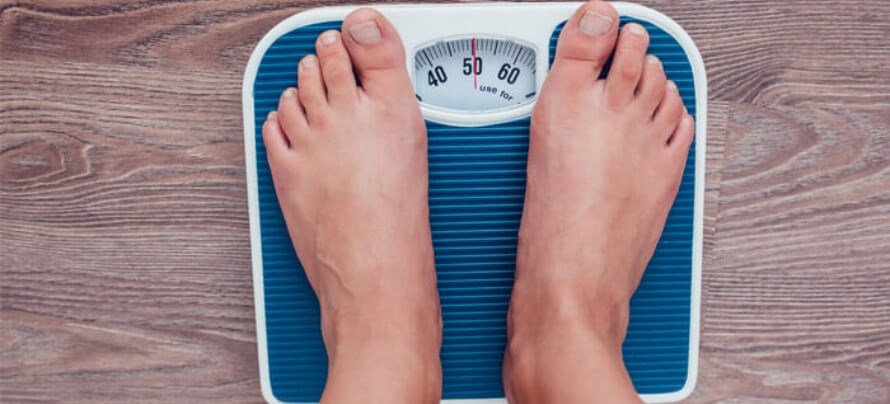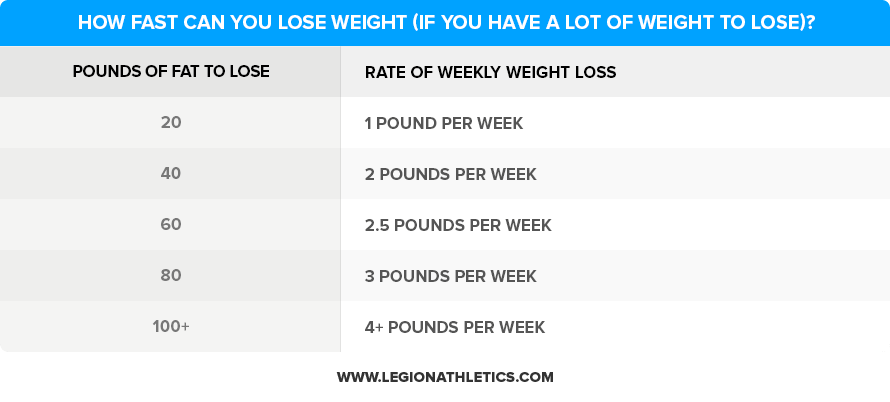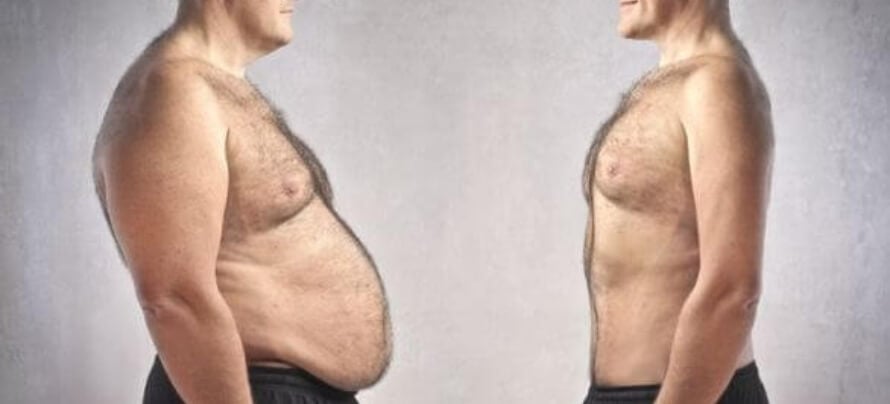Key Takeaways
- Most very overweight or obese people can lose two to four pounds of fat per week without losing muscle mass.
- You’ll be able to lose weight the fastest at the beginning of a diet, and your rate of weight loss will (and should) decrease as you approach your goal weight.
- Keep reading to learn whether or not you should try to lose weight this fast, how to lose weight as fast as possible without losing muscle, and more!
Google “how fast should I lose weight,” and you’ll get the same answer pretty much everywhere:
One pound per week.
And that’s not bad advice.
You’ve probably heard that a pound of fat contains 3,500 calories. To lose a pound of fat per week, then, you just need to eat 500 fewer calories per day than you burn (500 x 7 = 3,500).
Simple, easy to remember, and doable for most people.
There’s just one problem with this little weight loss heuristic:
If you have 25, 50, or 100+ pounds to lose, losing one pound per week means you’ll be dieting for months if not years.
That’s a long row to hoe, especially if you’ve tried and failed to lose weight many times in the past.
Now for the good news:
If you’re very overweight (25+% body fat as a man or 35+% as a woman), you can probably lose a lot more than one pound of fat per week.
In fact, if you know what you’re doing with your diet and training, you may be able to safely lose two, three, or even four pounds of fat per week.
Of course, this strategy isn’t without downsides.
You’ll be more hungry, you’ll have to be more strict about your diet, and you’ll probably need to do some exercise, too.
The payoff, though, is that you can lose fat two or three times faster than most personal trainers, dietitians, and weight loss gurus recommend, without risking your health or losing large amounts of muscle.
So, if you want to learn how fast you can safely lose weight when you have a lot of weight to lose, you want to keep reading.
In this article, you’ll learn …
- What “safe” weight loss really means
- How fast you can safely lose weight
- Whether or not you should try to lose weight as fast as possible
- How to lose weight as fast as possible
- And more …
Let’s start by taking an honest look at what constitutes “safe” weight loss.
- What Is “Safe” Weight Loss?
- Warning: You Don’t Just Want to Lose Weight
- How Fast Can Obese People Safely Lose Fat?
- Should You Try to Lose Weight as Fast as Possible?
- How to Lose Fat as Fast as Possible
- The Bottom Line on How Fast You Can Lose Fat
Table of Contents
+What Is “Safe” Weight Loss?

At this point you may be thinking, is losing two, three, or more pounds of fat per week safe?
Won’t that sink your metabolism, scramble your hormones, and skyrocket your hunger?
No, not necessarily.
The reason for this is that most of the negative effects of rapid weight loss occur in people who are already fairly lean.
That is, metabolic and hormonal hobgoblins mainly come out to play in people who are lean and trying to get even leaner, but they rarely rear their heads in people who have a lot of fat to lose.
We don’t need to get into the nitty gritty details, but suffice to say that rapid weight loss is no guarantee of metabolic or hormonal problems. Instead, it’s fast weight loss when you have little weight to lose that causes issues.
Read: “Metabolic Damage” and “Starvation Mode,” Debunked by Science
That said, there is such a thing as “unsafe” weight loss.
The main health problem dieters run into when they restrict their calories for weight loss is nutrient deficiencies.
In many cases, people who are very overweight are already eating fairly low-nutrient foods, and when they reduce their food intake to lose weight, their consumption of essential vitamins, minerals, and fatty acids plummets. In some cases, they also eliminate whole food groups (grains, dairy, fruit, red meat, etc.), which further increases the risk of nutrient deficiencies.
Thus, an “unsafe” weight loss diet is one that restricts your food intake to the point you’re unable to consume enough essential nutrients to support your health.
You can avoid these problems, though, by getting the majority of your calories from whole, nutrient-dense, minimally processed foods during your diet.
When you prioritize foods like this, you can eat a relatively small number of calories while still meeting your daily nutritional needs. (Taking a good multivitamin is also a good way to fill any nutritional “holes” in your diet).
Of course, the more you restrict your calories, the more careful you’ll need to be about the quality of the calories you do consume.
That is, if you’re only eating 1,500 calories per day, most of those calories should come from foods that are as high in nutrients as possible, and you won’t have much wiggle room for treats.
Summary: “Unsafe” weight loss really just means you’re eating so few calories that you’re unable to consume enough essential nutrients to support health, and you can avoid this problem by eating a healthy diet.
Warning: You Don’t Just Want to Lose Weight
While not a safety issue, per se, another common mistake many dieters make is solely focusing on losing weight, regardless of whether that weight comes from muscle or fat.
This is particularly true among people who are overweight or obese, who often develop a single-minded fixation on reaching a lower scale weight. While this is a worthy goal—you do want to lose weight—you still want to keep muscle loss to an absolute minimum.
Why?
Well, for one thing, losing a lot of muscle is a surefire way to wind up skinny fat. That is, you end up with very little muscle mass relative to how much body fat you have.
Second, more muscle and strength and less fat isn’t just good for your ego—it means fewer physical limitations, accidents, and disabilities and better overall health and longevity.
For instance, in an extensive five-year study involving 3,069 men and 589 women aged 30 to 82, scientists from the University of South Carolina found that those who best maintained their strength as they aged were three times less likely to experience any kind of physical impairment or disability later in life than those who least maintained their strength.
All in all, even if your main goal is just to lose weight, you should try to lose as little muscle mass as possible in the process.
You’ll be happier with how you look and feel, and you’ll enjoy better health and longevity.
Summary: Even when your primary goal is to lose a lot of weight as fast as possible, you want to do so in a way that minimizes muscle loss.
How Fast Can Obese People Safely Lose Fat?

Pretty darn fast.
The best example of this is a study conducted by scientists at the University of Las Palmas de Gran Canaria. In this case, the researchers had 15 overweight men aged 18 to 55 follow an absolutely backbreaking diet and workout program for four days.
The participants were put on a diet that provided just 10 percent of their total daily energy expenditure (TDEE) per day. That is, they maintained a 90 percent calorie deficit, and all of those calories came from either whey protein or sucrose (sugar).
If that wasn’t bad enough, they also walked for 8 hours per day and did another 45 minutes of a hand-cranking machine, so that they maintained a 5,000 calorie deficit per day.
After four days, they lost 4.4 pounds of pure body fat on average. Although they technically lost about 6.6 pounds of lean mass, most of this was due to losing water weight. After they were given a few days for their body’s hydration levels to return to normal, the researchers found they only lost about two pounds of actual muscle.
And if they’d been lifting weights and eating sufficient protein, chances are good they wouldn’t have lost much of any muscle.
Based on this, you could say that an upper limit for fat loss is about one pound per day.
The problem, of course, is that this is also totally unrealistic and unworkable for more than a few days. While four pounds of fat loss in four days is impressive, that’s not going to move the needle much if you have 50 or more pounds to lose.
In other words, little sprints of weight loss like this look nice on paper, but they’re still a drop in the bucket in the big scheme of things.
So, what’s a more reasonable target?
How much fat can you consistently lose before your body starts chewing up muscle mass?
Scientists have also known for quite some time that the more body fat someone has, the faster they can typically lose it without losing muscle. In other words, the more body fat you have, the more fat you can lose over any given period of time.
Thanks to a study conducted by Seymour Alpert, a professor at the University of New Mexico, we can now estimate roughly when you’ll reach this point based on how much fat you have to lose.
Alpert parsed through data from previous studies that involved people in a calorie deficit whose body composition was also measured. Using several different mathematical models, he then compared how much fat and muscle the people lost compared to the size of their calorie deficit.
Based on his analysis, he found what he believes to be a maximum threshold of calories that the body can extract from body fat per day: 30 calories per pound of body fat per day.
We can use this formula to find how many pounds of fat you can lose per week before you start losing muscle.
First, find your body fat percentage.
For example, let’s say that Dan is 5’10, 220 pounds. Based on the guidelines in this article, Dan estimates he’s about 40 percent body fat (obese).
Next, he would find out how much total body fat he has in pounds.
To find this number, Dan would multiply his weight by his body fat percentage.
220 x 40 percent = 88 total pounds of body fat.
Next, Dan would multiply his total fat mass in pounds by 30 (Alpert’s equation) to find how many calories of fat he could conceivably lose per day before he started to lose muscle.
88 x 30 = 2,600
That means Dan could realistically maintain a daily calorie deficit of about 2,600 calories per day without losing muscle.
To find how many pounds of fat he could realistically lose per week, he’d multiply the daily calorie deficit by 7.
2600 x 7 = 18,200
Then Dan would divide 18,200 by 3,500 (roughly the number of calories in a pound of body fat) to find how many pounds of body fat he could lose per week.
18,200 / 3,500 = 5.2 (which we can round to 5 pounds of body fat).
This means that Dan could expect to lose at most 5 pounds of body fat per week on average before he started losing significant amounts of muscle.
That said, this number will shrink along with Dan’s body fat stores. In other words, as he gets leaner, the maximum amount of fat he’ll be able to lose per week will also decrease, and he won’t be able to keep losing five pounds per week without losing muscle.
For example, let’s say Dan loses 30 pounds in 6 weeks (an absolute best case scenario, by the way), and now only has 58 pounds of body fat.
Because he has much less body fat than he did when he started his diet, he’s now only able to lose about 3.5 pounds of fat per week without losing muscle.
If he tried to keep losing 5 pounds of fat per week at this point, he’d be losing about 1.5 pounds of muscle per week, too.
So, although you can use Alpert’s equation to estimate the maximum amount of fat you can lose per week, you don’t necessarily want to aim for that rate of fat loss for more than a few weeks before recalculating and adjusting your diet accordingly.
What’s more, you probably don’t want to aim for that maximum rate of weight loss for more than a few days, anyway. Keep reading to learn why.
Summary: Most very overweight or obese people can lose fat at a maximum of around 0.5 to 1 pounds per day for short periods of time.
Should You Try to Lose Weight as Fast as Possible?

Of course, just because you can lose 0.5 to 1 pound of fat per day doesn’t mean you should.
Most people who attempt crash diets like this end up falling off the wagon and gaining back all of the weight they lost and then some.
The hunger, fatigue, cravings, and resultant binging and spasms of guilt can make dieting feel like a fool’s errand, and often pushes people into despondency and hopelessness.
You don’t want to do that.
That said, you also don’t necessarily want to take things “slow and steady” when you have a lot of weight to lose, either.
Research conducted by scientists at the University of Florida shows that the more weight people lose in the first few weeks of a diet, the more successfully they stick to their diet, the more weight they lose over the long term, and the more weight they keep off over the months and years after they reach their goal weight.
Why?
Because fast results create confidence in the diet, which creates adherence, which begets long-term results.
Thus, the best solution is to thread the needle between slow, steady weight loss and crash dieting, which looks something like this for most people:

This is going to be more or less the same for both men and women, too.
In other words, if you have more than 20 pounds of weight to lose, you can safely aim for a weekly rate of weight loss about halfway between the minimum most people aim for (1 pound per week) and the maximum conceivable rate (according to Alpert’s equation).
Remember that you’ll need to adjust your target rate of weight loss as you get leaner.
For example, let’s say you have 80 pounds to lose. You diet for six weeks, losing 18 pounds (three pounds per week).
At this point, you only have about 60 pounds to lose, and thus you’ll want to reduce your target rate of weight loss to 2.5 pounds per week. You diet for another eight weeks, losing another 20 pounds (2.5 pounds per week).
Now, you only have 40 pounds to lose, in which case you’ll want to aim for a weekly weight loss of around 2 pounds per week, and so on and so forth.
Summary: Most very overweight or obese people should aim to lose weight at a rate of around 2 to 4 pounds per week, which is fast enough to see rapid results but not so fast that it’s likely to cause muscle loss.
How to Lose Fat as Fast as Possible

To lose fat as fast as possible without losing muscle, you need to follow these five steps:
- Use an aggressive calorie deficit of about 40 percent.
- Eat a high-protein and high-carb diet.
- Do a lot of heavy, compound weightlifting.
- Keep your cardio to a minimum.
- Take supplements proven to accelerate fat loss
Before you read any further, though, take a moment to ensure you actually need to follow this plan.
If you have less than 20 pounds to lose or you’re less than 25+% body fat as a man or 35+% as a woman, you should aim to lose weight at a slower rate. Trying to lose weight too fast will cause more harm than good, and will almost certainly result in muscle loss, lethargy, poor performance in the gym, extreme hunger, and other nasty side effects.
Read this article if this applies to you:
The Complete Guide to Safely and Healthily Losing Weight Fast
Even if you have more than 20 pounds to lose, if you’ve never followed a structured diet like this before, I strongly urge you to read this article, follow the advice, and then consider losing weight faster if you aren’t happy with the results.
Why?
Because no one needs a drastic weight loss diet to get the body they want. They just need to stick to an effective diet long enough for it to work.
That said, if you have more than 20 pounds to lose and you want to get rid of your excess weight ASAP, you want to follow this plan:
1. Use an aggressive calorie deficit of about 40 percent.
This is enough to produce around two to four pounds of weight loss for most people who are very overweight or obese.
To find this number, you’ll first need to calculate your total daily energy expenditure (TDEE), or how many calories you burn per day. Read this article to learn how:
Once you know your TDEE, multiply it by 0.6. (To maintain a calorie deficit of 40 percent, you’ll eat 60 percent of your TDEE per day).
For example, if you find your TDEE is around 3,000 calories per day, here’s how the math would look:
3,000 x 0.6 = 1,800.
Thus, you’d want to eat around 1,800 calories per day.
(And if you’d like even more specific advice about how many calories, how much of each macronutrient, and which foods you should eat to reach your fitness goals, take the Legion Diet Quiz.)
Read: How Fast Can You Lose Fat without Losing Muscle? (According to Science)
2. Eat a very high-protein diet.
While the scientific search for the “One True Diet” continues, there’s one thing we know for certain: it’s going to involve eating a lot of protein.
The bottom line is study after study after study confirms that high-protein dieting is superior, in every way, to low-protein dieting.
Specifically, people who eat more protein …
- Lose fat faster
- Gain more muscle
- Burn more calories
- Experience less hunger
- Have stronger bones
- Generally enjoy better moods
This is even more important when you restrict your calorie intake for fat loss, as adequate protein intake plays a major role in preserving lean mass.
So, how much protein you should be eating?
Well, this article breaks it all down, but the long story short is when aggressively cutting like this, you want to get around 1 gram of protein per pound of body weight per day.
That might seem like a lot, but it’s necessary for avoiding muscle loss when you’re losing weight this fast.
Read: Should You Use a Protein Sparing Modified Fast to Lose Weight?
Using the example from earlier, our 220-pound Dan would want to eat around 220 grams of protein per day.
For most very overweight or obese people, this will work out to around 50 percent of your cutting calories.
After setting your protein intake, you can divide the rest of your calories between carbs and fat. That is, if you get 50 percent of your calories from protein, you’d get 25 percent of your calories from both carbs and fat.
You can eat more or less fat or carbs than this, but I recommend you get at least 15 percent of your calories from fat and carbs.
That is, you can increase your carbs as high as 35 percent of calories and reduce your fat as low as 15 percent of calories, or vice versa, but I don’t recommend you stray outside of these ranges.
Extremely low-fat and low-carb dieting can cause a variety of problems, and maintaining at least some carbs and fat in your diet tends to produce better long-term results.
And again, if you feel confused about how many calories, how much of each macronutrient, and which foods you should eat to reach your fitness goals, take the Legion Diet Quiz to learn exactly what diet is right for you.
3. Do some heavy, compound weightlifting.

There are many ways to train your muscles, and when the goal is gaining size and strength as quickly as possible, nothing beats heavy compound weightlifting.
It’s better than workout machines, “pump” classes, bodyweight exercises, Yoga, Pilates, and everything else you can do to develop muscle definition.
What do I mean by “heavy compound” lifting, though?
By “heavy,” I mean that you should work primarily with weights in the range of 75 to 85% of your one-rep max (1RM), which includes weights that you can do 6 to 10 reps with before failing.
And by “compound,” I mean that you should focus your efforts on exercises that train several major muscle groups, like the squat, deadlift, and bench press.
Training this way doesn’t just help you build more muscle—it can also help you lose fat faster.
Although heavy strength training may not leave you in the same sweaty, heart-pounding, breathless mess as high-rep, low-weight workouts or cardio, it still burns about as many calories.
This is largely thanks to what’s known as the “afterburn effect,” which is the rise in metabolic rate that occurs between sets and after your workout as your body recovers. Research shows that this can add up to several hundred calories over the days after an intense weightlifting workout.
Research also shows that the big compound movements like the squat, bench press, and deadlift are the types of exercises that produce the greatest increases in metabolic rate.
So, if you want to preserve as much muscle and burn as much fat as possible when you cut, then you want to do heavy pushing, pulling, and squatting.
That said, you can also easily overdo it when following a very low-calorie diet like this one, which is why I recommend you don’t lift weights more than three times per week while following this particular protocol.
You can do more than this, but there’s little upside and your risk of injury and burnout rises quickly.
If you’re looking for an effective, three-day per week strength training program, read this article:
The 12 Best Science-Based Strength Training Programs for Gaining Muscle and Strength
4. Do some easy cardio.
You don’t have to do cardio to lose weight—proper dieting alone is enough.
That said, doing some cardio can significantly speed up weight loss, and if you do it correctly, it comes with more or less no downsides and quite a few additional health benefits.
Read: Can You Get All of the Benefits of Cardio by Lifting Weights?
What kind of cardio is best?
It might surprise you to hear this, but definitely not high-intensity interval training (HIIT). While HIIT, circuit training, and other kinds of high-intensity cardio are in vogue for weight loss right now, they’re a poor option when you’re severely restricting your calories for fat loss.
For one thing, you’ll already be in such a large calorie deficit that the slight boost in calorie burning won’t make a major difference in your weight loss.
Second, it’s very easy to overdo high-intensity interval training when you’re heavily restricting your calories. Extreme fatigue, joint pain, and burnout are the usual result, and the risks simply aren’t worth the meager rewards.
So, what should you do instead?
Easy cardio.
A good starting place is 30 minutes of walking at a comfortable pace per day. This is enough to slightly boost fat loss and significantly improve your health, while being easy enough that it doesn’t interfere with your weightlifting workouts or quality of life.
Read: The Easiest Cardio Workout You Can Do (That Actually Works)
5. Take supplements proven to accelerate fat loss.

I saved this for last because it’s the least important piece of the puzzle.
Unfortunately, no amount of weight loss pills and powders are going to give you the body you want.
Supplements don’t build great physiques. Proper training and nutrition does. And that will never change. Supplementation will never overshadow exercise and diet.
That said, there are safe, natural substances that have been scientifically proven to boost fat loss, strength, muscle growth, endurance, and your general health and well-being.
If you know how to drive fat loss with proper eating and exercise, like we’ve just covered, then certain supplements can help speed up the process. (And if you’d like to know exactly what supplements to take to reach your fitness goals, take the Legion Supplement Finder Quiz.)
Based on my personal experience training for over 10 years, and working with thousands of people, I’m comfortable saying that a proper weight loss supplementation routine can increase fat loss by about 30 to 50%.
And here are those supplements:
3 to 6 milligrams of caffeine per kilogram of body weight per day.
As weight loss boils down to energy consumed versus energy expended, caffeine helps you lose fat by increasing your body’s daily energy expenditure.
Caffeine also improves strength, muscle endurance, and anaerobic performance, and also reverses the “morning weakness” experienced by many weightlifters.
Part of maximizing the fat loss benefits of caffeine is preventing your body from building up too much of a tolerance, however. The best way to do this is to limit intake, of course.
Here’s what I recommend:
- Before training, supplement with 3 to 6 mg caffeine per kg of body weight. If you’re not sure of your caffeine sensitivity, start with 3 mg/kg and work up from there.
- Keep your daily intake at or below 6 mg per kg of body weight. Don’t have 6 mg/kg before training and then drink a couple of coffees throughout the day.
- Include 1 to 2 low-caffeine days per week, and 1 no-caffeine day per week. A low day should be half your normal intake, and a no day means less than 50 mg of caffeine (you can have a cup or two of tea, but no coffee, energy drinks, caffeine pills, etc.).
Personally I get my caffeine from Legion’s pre-workout, Pulse, which contains 350 mg of caffeine per serving along with clinically effective dosages of 5 other ingredients scientifically proven to improve workout performance:
- Beta-Alanine. Beta-alanine is a naturally occurring amino acid that reduces exercise-induced fatigue, improves anaerobic exercise capacity, and can accelerate muscle growth.
- Citrulline Malate. Citrulline is an amino acid that improves muscle endurance, relieves muscle soreness, and improves aerobic performance.
- Betaine. Betaine is a compound found in plants like beets that improves muscle endurance, and increases strength.
- Ornithine. Ornithine is an amino acid found in high amounts in dairy and meat that reduces fatigue in prolonged exercise and promotes lipid oxidation (the burning of fat for energy as opposed to carbohydrate or glycogen).
- Theanine. Theanine is an amino acid found primarily in tea that reduces the effects of mental and physical stress, increases the production of nitric oxide, which improves blood flow, and improves alertness, focus, attention, memory, mental task performance, and mood.
And what you won’t find in Pulse is equally special:
- No artificial sweeteners or flavors.
- No artificial food dyes.
- No unnecessary fillers, carbohydrate powders, or junk ingredients.
The bottom line is if you want to know what a pre-workout is supposed to feel like … if you want to experience the type of energy rush and performance boost that only clinically effective dosages of scientifically validated ingredients can deliver … then you want to try Pulse.
0.1 to 0.2 milligrams of yohimbine per kilogram of bodyweight before training.
Yohimbine is a natural substance that increases fat loss, and is particularly helpful with losing “stubborn” fat in the belly, hip, and thigh regions.
There’s a catch, though.
Studies show that yohimbine only works when insulin levels are lowest. And that means it can only help you lose fat faster if you train in a fasted state.
In terms of a specific yohimbine supplement to take, I recommend you check out Legion’s pre-workout fat burner Forge today.
Every serving contains clinically effective doses of yohimbine, HMB, and CDP-choline, which help you burn stubborn fat faster, preserve your muscle, and have better workouts.
1 to 2 servings of my fat burner Phoenix per day.
Phoenix is a fat burner Legion developed that contains seven natural compounds proven to help you lose fat faster, including synephrine, green tea extract, and forskolin.
The bottom line is if you want to lose fat faster without taking a bunch of stimulants or harsh chemicals, then you want to try Phoenix today.
And again, if you feel confused about what supplements you should take to reach your goals, take the Legion Supplement Finder Quiz to learn exactly what supplements are right for you. It’s the best way to ensure you get the most out of your supplement regimen.
The Bottom Line on How Fast You Can Lose Fat
Although many people think fast weight loss is inherently unsafe, this isn’t true.
In reality, “unsafe” weight loss just means you’re restricting your calories to the point you’re unable to consume enough essential nutrients to support your health. So long as you eat a healthy diet, this shouldn’t be an issue.
A more common problem people run into who are trying to lose weight as fast as possible is muscle loss. Simply put, even if your primary goal is to lose weight as fast as possible, you still want to lose as little muscle as possible, both for your looks and your health and longevity.
If someone has more than 20 pounds of weight to lose, or they’re more than 25 percent body fat as a man or 35 percent body fat as a woman, they can safely lose around 2 to 4 pounds of fat per week without losing muscle.
To do this successfully, though, you need to follow these five steps:
- Use an aggressive calorie deficit of about 40 percent.
- Eat a very high-protein diet.
- Do some heavy, compound weightlifting.
- Do some easy cardio.
- Take supplements proven to accelerate fat loss.
Do that, and you’ll lose fat remarkably fast.
Although I’ve mentioned this a few times, it bears repeating:
Before you try to lose weight following this plan, try a more moderate, sustainable approach first.
Read this article to learn what this looks like:
The Complete Guide to Safely and Healthily Losing Weight Fast
If you still have your heart set on losing fat as fast as possible, remember that your rate of weight loss will (and should) decrease as you get leaner.
That is, you could lose four pounds per week at the beginning of your diet, and this might slow to two pounds per week toward the end as you approach your goal weight.
This is normal, natural, and desirable, because trying to lose weight too fast as you get leaner will result in muscle loss.
Stick to the plan, though, and you’ll lose several pounds of fat per week for months without losing muscle.
What’s your take on losing fat as fast as possible? Have anything else to share? Let me know in the comments below!
Scientific References +
- GALITZKY, J., TAOUIS, M., BERLAN, M., RIVIÈRE, D., GARRIGUES, M., & LAFONTAN, M. (1988). α2‐Antagonist compounds and lipid mobilization: evidence for a lipid mobilizing effect of oral yohimbine in healthy male volunteers. European Journal of Clinical Investigation, 18(6), 587–594. https://doi.org/10.1111/j.1365-2362.1988.tb01272.x
- Millan, M. J., Newman-Tancredi, A., Audinot, V., Cussac, D., Lejeune, F., Nicolas, J. P., Cogé, F., Galizzi, J. P., Boutin, J. A., Rivet, J. M., Dekeyne, A., & Gobert, A. (2000). Agonist and antagonist actions of yohimbine as compared to fluparoxan at α2-adrenergic receptors (AR)s, serotonin (5-HT)(1A), 5-HT(1B), 5-HT(1D) and dopamine D2 and D3 receptors. Significance for the modulation of frontocortical monoaminergic transmission and depressive states. Synapse, 35(2), 79–95. https://doi.org/10.1002/(SICI)1098-2396(200002)35:2<79::AID-SYN1>3.0.CO;2-X
- Ostojic, S. M. (2006). Yohimbine: The effects on body composition and exercise performance in soccer players. Research in Sports Medicine, 14(4), 289–299. https://doi.org/10.1080/15438620600987106
- Haskell, C. F., Kennedy, D. O., Milne, A. L., Wesnes, K. A., & Scholey, A. B. (2008). The effects of l-theanine, caffeine and their combination on cognition and mood. Biological Psychology, 77(2), 113–122. https://doi.org/10.1016/j.biopsycho.2007.09.008
- Nobre, A. C., Rao, A., & Owen, G. N. (2008). L-theanine, a natural constituent in tea, and its effect on mental state. Asia Pacific Journal of Clinical Nutrition, 17(SUPPL. 1), 167–168. https://doi.org/10.6133/apjcn.2008.17.s1.40
- Foxe, J. J., Morie, K. P., Laud, P. J., Rowson, M. J., De Bruin, E. A., & Kelly, S. P. (2012). Assessing the effects of caffeine and theanine on the maintenance of vigilance during a sustained attention task. Neuropharmacology, 62(7), 2320–2327. https://doi.org/10.1016/j.neuropharm.2012.01.020
- Bryan, J. (2008). Psychological effects of dietary components of tea: Caffeine and L-theanine. In Nutrition Reviews (Vol. 66, Issue 2, pp. 82–90). https://doi.org/10.1111/j.1753-4887.2007.00011.x
- Siamwala, J. H., Dias, P. M., Majumder, S., Joshi, M. K., Sinkar, V. P., Banerjee, G., & Chatterjee, S. (2013). L-Theanine promotes nitric oxide production in endothelial cells through eNOS phosphorylation. Journal of Nutritional Biochemistry, 24(3), 595–605. https://doi.org/10.1016/j.jnutbio.2012.02.016
- Kimura, K., Ozeki, M., Juneja, L. R., & Ohira, H. (2007). l-Theanine reduces psychological and physiological stress responses. Biological Psychology, 74(1), 39–45. https://doi.org/10.1016/j.biopsycho.2006.06.006
- Sugino, T., Shirai, T., Kajimoto, Y., & Kajimoto, O. (2008). l-Ornithine supplementation attenuates physical fatigue in healthy volunteers by modulating lipid and amino acid metabolism. Nutrition Research, 28(11), 738–743. https://doi.org/10.1016/j.nutres.2008.08.008
- Lee, E. C., Maresh, C. M., Kraemer, W. J., Yamamoto, L. M., Hatfield, D. L., Bailey, B. L., Armstrong, L. E., Volek, J. S., McDermott, B. P., & Craig, S. A. S. (2010). Ergogenic effects of betaine supplementation on strength and power performance. Journal of the International Society of Sports Nutrition, 7. https://doi.org/10.1186/1550-2783-7-27
- Trepanowski, J. F., Farney, T. M., McCarthy, C. G., Schilling, B. K., Craig, S. A., & Bloomer, R. J. (2011). The effects of chronic betaine supplementation on exercise performance, skeletal muscle oxygen saturation, and associated biochemical parameters in resistance trained men. Journal of Strength and Conditioning Research, 25(12), 3461–3471. https://doi.org/10.1519/JSC.0b013e318217d48d
- Bendahan, D., Mattei, J. P., Ghattas, B., Confort-Gouny, S., Le Guern, M. E., & Cozzone, P. J. (2002). Citrulline/malate promotes aerobic energy production in human exercising muscle. British Journal of Sports Medicine, 36(4), 282–289. https://doi.org/10.1136/bjsm.36.4.282
- Pérez-Guisado, J., & Jakeman, P. M. (2010). Citrulline malate enhances athletic anaerobic performance and relieves muscle soreness. Journal of Strength and Conditioning Research, 24(5), 1215–1222. https://doi.org/10.1519/JSC.0b013e3181cb28e0
- Kern, B. D., & Robinson, T. L. (2011). Effects of β-alanine supplementation on performance and body composition in collegiate wrestlers and football players. Journal of Strength and Conditioning Research, 25(7), 1804–1815. https://doi.org/10.1519/JSC.0b013e3181e741cf
- Smith, A. E., Walter, A. A., Graef, J. L., Kendall, K. L., Moon, J. R., Lockwood, C. M., Fukuda, D. H., Beck, T. W., Cramer, J. T., & Stout, J. R. (2009). Effects of β-alanine supplementation and high-intensity interval training on endurance performance and body composition in men; a double-blind trial. Journal of the International Society of Sports Nutrition, 6. https://doi.org/10.1186/1550-2783-6-5
- Derave, W., Özdemir, M. S., Harris, R. C., Pottier, A., Reyngoudt, H., Koppo, K., Wise, J. A., & Achten, E. (2007). β-Alanine supplementation augments muscle carnosine content and attenuates fatigue during repeated isokinetic contraction bouts in trained sprinters. Journal of Applied Physiology, 103(5), 1736–1743. https://doi.org/10.1152/japplphysiol.00397.2007
- Mora-Rodríguez, R., Pallarés, J. G., López-Samanes, Á., Ortega, J. F., & Fernández-Elías, V. E. (2012). Caffeine ingestion reverses the circadian rhythm effects on neuromuscular performance in highly resistance-trained men. PLoS ONE, 7(4). https://doi.org/10.1371/journal.pone.0033807
- Beck, T. W., Housh, T. J., Schmidt, R. J., Johnson, G. O., Housh, D. J., Coburn, J. W., & Malek, M. H. (2006). The acute effects of a caffeine-containing supplement on strength, muscular endurance, and anaerobic capabilities. Journal of Strength and Conditioning Research, 20(3), 506–510. https://doi.org/10.1519/18285.1
- Astorino, T. A., Rohmann, R. L., & Firth, K. (2008). Effect of caffeine ingestion on one-repetition maximum muscular strength. European Journal of Applied Physiology, 102(2), 127–132. https://doi.org/10.1007/s00421-007-0557-x
- Astrup, A., Toubro, S., Cannon, S., Hein, P., Breum, L., & Madsen, J. (1990). Caffeine: A double-blind, placebo-controlled study of its thermogenic, metabolic, and cardiovascular effects in healthy volunteers. American Journal of Clinical Nutrition, 51(5), 759–767. https://doi.org/10.1093/ajcn/51.5.759
- Farinatti, P. T. V., & Castinheiras Net, A. G. (2011). The effect of between-set rest intervals on the oxygen uptake during and after resistance exercise sessions performed with large-and small-muscle mass. Journal of Strength and Conditioning Research, 25(11), 3181–3190. https://doi.org/10.1519/JSC.0b013e318212e415
- Marx, J. O., Ratamess, N. A., Nindl, B. C., Gotshalk, L. A., Volek, J. S., Dohi, K., Bush, J. A., Gómez, A. L., Mazzetti, S. A., Fleck, S. J., Häkkinen, K., Newton, R. U., & Kraemer, W. J. (2001). Low-volume circuit versus high-volume periodized resistance training in women. Medicine and Science in Sports and Exercise, 33(4), 635–643. https://doi.org/10.1097/00005768-200104000-00019
- Helms, E. R., Aragon, A. A., & Fitschen, P. J. (2014). Evidence-based recommendations for natural bodybuilding contest preparation: Nutrition and supplementation. In Journal of the International Society of Sports Nutrition (Vol. 11, Issue 1, pp. 1–20). BioMed Central Ltd. https://doi.org/10.1186/1550-2783-11-20
- Wayne W. Campbell and Minghua Tang Protein Intake, Weight Loss, and Bone Mineral Density in Postmenopausal Women
- Paddon-Jones, D., Westman, E., Mattes, R. D., Wolfe, R. R., Astrup, A., & Westerterp-Plantenga, M. (2008). Protein, weight management, and satiety. American Journal of Clinical Nutrition, 87(5). https://doi.org/10.1093/ajcn/87.5.1558s
- Westerterp, K. R. (2004). Diet induced thermogenesis. In Nutrition and Metabolism (Vol. 1, p. 5). BioMed Central. https://doi.org/10.1186/1743-7075-1-5
- Helms, E. R., Aragon, A. A., & Fitschen, P. J. (2014). Evidence-based recommendations for natural bodybuilding contest preparation: Nutrition and supplementation. In Journal of the International Society of Sports Nutrition (Vol. 11, Issue 1, pp. 1–20). BioMed Central Ltd. https://doi.org/10.1186/1550-2783-11-20
- Evans, E. M., Mojtahedi, M. C., Thorpe, M. P., Valentine, R. J., Kris-Etherton, P. M., & Layman, D. K. (2012). Effects of protein intake and gender on body composition changes: A randomized clinical weight loss trial. Nutrition and Metabolism, 9. https://doi.org/10.1186/1743-7075-9-55
- Dulloo AG, Jacquet J, Girardier L. Poststarvation hyperphagia and body fat overshooting in humans: a role for feedback signals from lean and fat tissues. - PubMed - NCBI. (n.d.). Retrieved May 18, 2020, from https://www.ncbi.nlm.nih.gov/pubmed/9062520
- POLLACK, H. (1953). Caloric equivalents of gained or lost weight. Metabolism: Clinical and Experimental, 2(3), 283. https://doi.org/10.1093/ajcn/6.5.542
- Calbet, J. A. L., Ponce-González, J. G., Pérez-Suárez, I., de la Calle Herrero, J., & Holmberg, H. C. (2015). A time-efficient reduction of fat mass in 4 days with exercise and caloric restriction. Scandinavian Journal of Medicine and Science in Sports, 25(2), 223–233. https://doi.org/10.1111/sms.12194
- Brill, P. A., Macera, C. A., Davis, D. R., Blair, S. N., & Gordon, N. (2000). Muscular strength and physical function. Medicine and Science in Sports and Exercise, 32(2), 412–416. https://doi.org/10.1097/00005768-200002000-00023
- Calton, J. B. (2010). Prevalence of micronutrient deficiency in popular diet plans. Journal of the International Society of Sports Nutrition, 7, 24. https://doi.org/10.1186/1550-2783-7-24
- Engel, M. G., Kern, H. J., Brenna, J. T., & Mitmesser, S. H. (2018). Micronutrient gaps in three commercial weight-loss diet plans. Nutrients, 10(1). https://doi.org/10.3390/nu10010108
- Damms-Machado, A., Weser, G., & Bischoff, S. C. (2012). Micronutrient deficiency in obese subjects undergoing low calorie diet. Nutrition Journal, 11, 34. https://doi.org/10.1186/1475-2891-11-34










